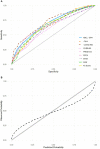Assessment of the ABC2-SPH risk score to predict invasive mechanical ventilation in COVID-19 patients and comparison to other scores
- PMID: 38046414
- PMCID: PMC10690599
- DOI: 10.3389/fmed.2023.1259055
Assessment of the ABC2-SPH risk score to predict invasive mechanical ventilation in COVID-19 patients and comparison to other scores
Abstract
Background: Predicting the need for invasive mechanical ventilation (IMV) is important for the allocation of human and technological resources, improvement of surveillance, and use of effective therapeutic measures. This study aimed (i) to assess whether the ABC2-SPH score is able to predict the receipt of IMV in COVID-19 patients; (ii) to compare its performance with other existing scores; (iii) to perform score recalibration, and to assess whether recalibration improved prediction.
Methods: Retrospective observational cohort, which included adult laboratory-confirmed COVID-19 patients admitted in 32 hospitals, from 14 Brazilian cities. This study was conducted in two stages: (i) for the assessment of the ABC2-SPH score and comparison with other available scores, patients hospitalized from July 31, 2020, to March 31, 2022, were included; (ii) for ABC2-SPH score recalibration and also comparison with other existing scores, patients admitted from January 1, 2021, to March 31, 2022, were enrolled. For both steps, the area under the receiving operator characteristic score (AUROC) was calculated for all scores, while a calibration plot was assessed only for the ABC2-SPH score. Comparisons between ABC2-SPH and the other scores followed the Delong Test recommendations. Logistic recalibration methods were used to improve results and adapt to the studied sample.
Results: Overall, 9,350 patients were included in the study, the median age was 58.5 (IQR 47.0-69.0) years old, and 45.4% were women. Of those, 33.5% were admitted to the ICU, 25.2% received IMV, and 17.8% died. The ABC2-SPH score showed a significantly greater discriminatory capacity, than the CURB-65, STSS, and SUM scores, with potentialized results when we consider only patients younger than 80 years old (AUROC 0.714 [95% CI 0.698-0.731]). Thus, after the ABC2-SPH score recalibration, we observed improvements in calibration (slope = 1.135, intercept = 0.242) and overall performance (Brier score = 0.127).
Conclusion: The ABC2-SPHr risk score demonstrated a good performance to predict the need for mechanical ventilation in COVID-19 hospitalized patients under 80 years of age.
Keywords: COVID-19; intensive care unit; invasive mechanical ventilation; prognosis; risk assessment.
Copyright © 2023 Cimini, Delfino-Pereira, Pires, Ramos, Gomes, Jorge, Fagundes, Garcia, Pessoa, de Carvalho, Ponce, Rios, Anschau, Vigil, Bartolazzi, Grizende, Vietta, Goedert, Nascimento, Vianna, Vasconcelos, Alvarenga, Chatkin, Machado Rugolo, Ruschel, Zandoná, Menezes, Castro, Souza, Carneiro, Bicalho, Cunha, Sacioto, Lutkmeier, Oliveira, Andrade, Menezes, Ribeiro and Marcolino.
Conflict of interest statement
The authors declare that the research was conducted in the absence of any commercial or financial relationships that could be construed as a potential conflict of interest.
Figures



References
-
- DeCuir J, Surie D, Zhu Y, Gaglani M, Ginde AA, Douin DJ, et al. Effectiveness of monovalent mRNA COVID-19 vaccination in preventing COVID-19–associated invasive mechanical ventilation and death among immunocompetent adults during the omicron variant period — IVY network, 19 U.S. states, February 1, 2022–January 31, 2023. MMWR Morb Mortal Wkly Rep. (2023) 72:463–8. doi: 10.15585/mmwr.mm7217a3 - DOI - PubMed
-
- Tenforde MW, Self WH, Gaglani M, Ginde AA, Douin DJ, Talbot HK, et al. Effectiveness of mRNA vaccination in preventing COVID-19-associated invasive mechanical ventilation and death-United States, March 2021–January 2022. MMWR Morb Mortal Wkly Rep. (2022) 71:459–65. doi: 10.15585/mmwr.mm7112e1 - DOI - PMC - PubMed
-
- Marcolino MS, Pires MC, Ramos LEF, Silva RT, Oliveira LM, Carvalho RLR, et al. ABC2-SPH risk score for in-hospital mortality in COVID-19 patients: development, external validation and comparison with other available scores. Int J Infect Dis. (2021) 110:281–308. doi: 10.1016/j.ijid.2021.07.049, PMID: - DOI - PMC - PubMed
LinkOut - more resources
Full Text Sources

